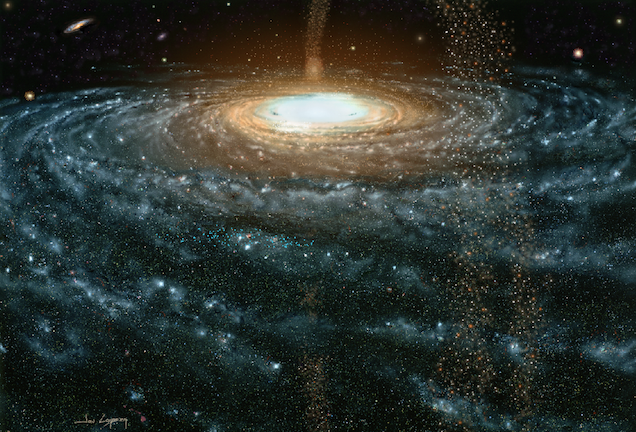Using the Keck II and Gemini telescopes on Maunakea , Pieter van Dokkum and colleagues observed a number of ultra-diffuse galaxies (UDGs) in the Coma Cluster, almost local to us at 300 mly. Their first observations*, made in 2015, on the largest of these UDGs suggest it may be made almost entirely of dark matter. They appear to be convinced of it. To be sure, it is a very unusual object, and their observations, while limited, makes it even more curious for that reason alone : there is not much to "see"!
The UDG that stood out is Dragonfly 44. This "object" appears to have a mass approximating the Milky Way, but contains only about 0.01 percent ordinary, visible matter. Or at least that is how it "appears", based on visible imaging, since you cannot "see" dark matter. The velocities of visible stars indicate its mass is enormous, and that something other than ordinary matter must be making up 99.99% of this object, i.e. mass which is not observed.
In a more recent paper** from 2019, using the Keck Cosmic Web Imager***, van Dokkum et al. obtained no evidence for rotation in this "galaxy", suggesting this is not a typical UDG. This observation distinguishes it from the "high-spin tail of the normal dwarf galaxy distribution" found in many of these diffuse objects.
A significant reference search on this object revels very little else about it (with constraints on my search abilities), and nothing to challenge van Dokkum et al.'s conclusions, or any retraction(s). Dragonfly 44 appears to be a rare object, and possibly made almost entirely of dark matter. But how could this be true if so much of the universe's mass is supposed to be dark matter? If dark matter can form one galaxy, it should be able to form many of them. Yet we can apparently "see" only one, and that one is almost next door!
So, where are all the dark matter galaxies?
* https://www.space.com/33850-weird-galaxy-is-mostly-dark-matter.html
** https://arxiv.org/pdf/1904.04838.pdf (preprint, Astrophysical Journal)
*** http://www.keckobservatory.org/spiraling-gas/
The UDG that stood out is Dragonfly 44. This "object" appears to have a mass approximating the Milky Way, but contains only about 0.01 percent ordinary, visible matter. Or at least that is how it "appears", based on visible imaging, since you cannot "see" dark matter. The velocities of visible stars indicate its mass is enormous, and that something other than ordinary matter must be making up 99.99% of this object, i.e. mass which is not observed.
In a more recent paper** from 2019, using the Keck Cosmic Web Imager***, van Dokkum et al. obtained no evidence for rotation in this "galaxy", suggesting this is not a typical UDG. This observation distinguishes it from the "high-spin tail of the normal dwarf galaxy distribution" found in many of these diffuse objects.
A significant reference search on this object revels very little else about it (with constraints on my search abilities), and nothing to challenge van Dokkum et al.'s conclusions, or any retraction(s). Dragonfly 44 appears to be a rare object, and possibly made almost entirely of dark matter. But how could this be true if so much of the universe's mass is supposed to be dark matter? If dark matter can form one galaxy, it should be able to form many of them. Yet we can apparently "see" only one, and that one is almost next door!
So, where are all the dark matter galaxies?
* https://www.space.com/33850-weird-galaxy-is-mostly-dark-matter.html
** https://arxiv.org/pdf/1904.04838.pdf (preprint, Astrophysical Journal)
*** http://www.keckobservatory.org/spiraling-gas/
Last edited:



